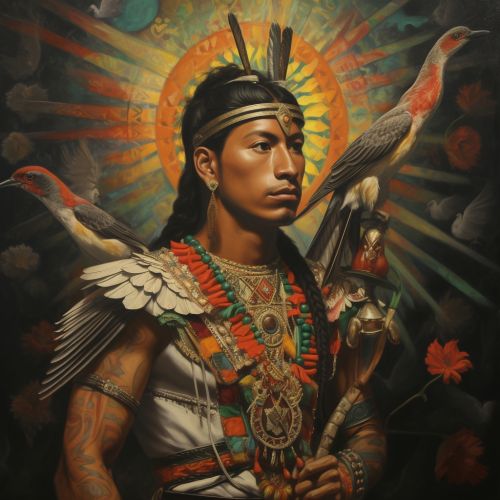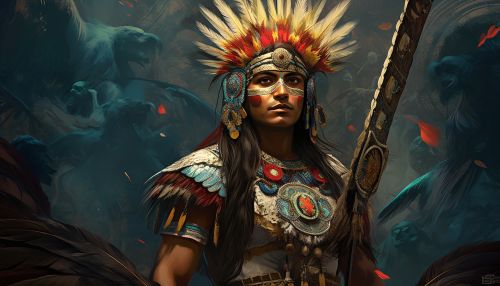Huitzilopochtli
Origins
Huitzilopochtli, known as the "Hummingbird of the South", is a central figure in the pantheon of gods within the Aztec religion. The deity is often associated with war, sun, and human sacrifice, embodying the Aztec's complex spiritual beliefs and practices. The name Huitzilopochtli is derived from the Nahuatl language, with "Huitzilin" meaning hummingbird and "opochtli" meaning left or south. The Aztecs believed that warriors who died in battle returned as hummingbirds, reinforcing Huitzilopochtli's association with warfare.


Mythology
In Aztec mythology, Huitzilopochtli is a son of the primordial androgynous god Ometeotl. His birth story is one of violence and conflict, reflecting his role as a war deity. According to the myth, Huitzilopochtli's mother, Coatlicue, became pregnant with him when a ball of feathers fell into the temple where she was sweeping. This unexpected pregnancy enraged her other children, who plotted to kill her. However, upon learning of the plot, Huitzilopochtli emerged fully armed from his mother's womb and slew his siblings, asserting his dominance as a warrior god.
Worship and Rituals
The worship of Huitzilopochtli was central to the religious life of the Aztecs. He was considered the patron god of the Aztec capital, Tenochtitlan, and his temple, the Templo Mayor, was the most important religious site in the city. Rituals dedicated to Huitzilopochtli often involved human sacrifice, a practice that the Aztecs believed was necessary to sustain the god's strength and ensure the continued cycle of the sun.
The most significant festival dedicated to Huitzilopochtli was the Panquetzaliztli, held in the fifteenth month of the Aztec calendar. During this festival, a captive warrior was chosen to impersonate the god, living as Huitzilopochtli for a year before being sacrificed in a grand ceremony. This ritual was believed to renew the god's energy and ensure the continued prosperity of the Aztec people.
Symbolism and Iconography
Huitzilopochtli is often depicted as a warrior, reflecting his association with warfare and the sun. He is typically shown with a hummingbird helmet and holding a xiuhcoatl, a fire serpent, which is a symbol of the sun's heat and power. Other common symbols associated with Huitzilopochtli include the color blue, eagle feathers, and the south, reinforcing his role as a solar deity and a directional god.
Legacy
The legacy of Huitzilopochtli extends beyond the fall of the Aztec empire. His image and mythology have been incorporated into various aspects of Mexican culture and identity. Today, Huitzilopochtli is often invoked as a symbol of Mexican nationalism and resistance against foreign domination, reflecting the enduring influence of Aztec culture and belief systems.
